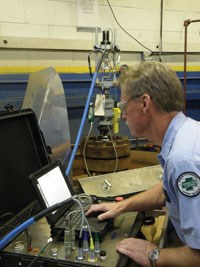Valve Service Shops are Not Created Equal
Not long ago, a common practice for companies in the chemical, power and refining industries was to have personnel on staff to handle many valve maintenance and service activities.
#maintenance-repair
One territory can have dozens of firms that offer valve maintenance and repair services. Stories shared by customers over the years clearly illustrate, however, that these shops are not all created equal. The specifics about how they differ vary, but the plotlines have been essentially the same: Valves coming back from the repair shop looked great. Testing, however, told a different story. Many of the valves have not been repaired correctly and are not performing to OEM requirements. This usually results in higher maintenance costs and/or lost production. It also can mean compromised product quality and unnecessary safety risks.
Careful consideration and a bit of homework are required in selecting a valve maintenance and repair provider. This article outlines criteria to consider.
OEM-AUTHORIZED
To become an authorized service provider, a shop must meet specific criteria the OEM sets in areas such as integrity, safety and environmental compliance. Plus, the team is required to complete the OEM’s training program. Usually, OEMs hold certified shops to high standards when it comes to facilities, equipment and personnel. Knowing that a service provider meets these criteria, however, gives companies added confidence that they are dealing with a reputable shop.
OEMs regularly audit their authorized service providers to ensure they are meeting the necessary performance standards. While ISO 9000 is a good standard to be followed, it is not a valve operating guideline. When it comes to valve assembly/testing and repair, the OEM is the body best equipped to conduct the detailed review necessary and is willing to share audit reports.
Additionally, OEM-authorized service providers have access to important details regarding the properties, construction and workings of a specific valve or part. This is because OEMs build their products to rigorous specifications. While it’s true that a valve or part can be re-engineered, only the OEM knows the original specs with certainty.
An OEM-authorized service provider also receives extensive product training from the OEM and can consult with the OEM’s engineers to diagnose problems. An authorized shop will use OEM parts, rather than re-engineered parts, helping to ensure that the valve performs as expected.
Finally, not using an OEM-authorized service provider may void the manufacturer’s warranty.
ASSET MANAGEMENT TOOLS
A significant differentiator between valve service shops today is the ability to provide asset management tools. These tools put valve records—including repair data, repair records, test documentation, wiring diagrams and “before” and “after” photos”—in a single, easy to use, accessible database. The customer owns the data and can access that information 24 hours a day.
This added capability can simplify record-keeping for inspections and make it easier to meet reporting requirements. But asset management tools can be so much more than just a document management tool—they can be a plant manager’s best friend. Some, for example, provide analysis features and can assist in detecting trends for repairs, some manage inventory for optimization, others provide features such as “turn-around management” clouds where one can drag and drop valves for planning a turnaround. Others help with diagnostics and provide recommended solutions for resolving issues.
TRAINED TECHNICIANS
When a person chooses a physician, he or she is likely to consider degree of education, specialized training and other credentials. The same criteria should apply when choosing a valve service partner. Those choosing should ask to see a firm’s training certificates; and find out whether the technicians are trained in the latest OEM standards, as well as relevant standards from organizations such as the American Society of Mechanical Engineers. They also should ask whether the technicians’ certificates are up-to-date because training is not a one-time task, but a continuous process.
DIAGNOSTICS CAPABILITY
For example, a technician working with pressure-relief valves should have electronic valve testers that can test a valve in-line and in production (in-situ). For control and line valves, technicians should have a diagnostic unit that can compare current valve data to “Day One” baseline data. With a significant number of analog positioners still in use, such devices can help remove the guesswork from assessing valve health.
ACCESS TO INVENTORY
Certainly, it is impossible for a service provider to have every SKU in its warehouse. But affiliation with a network of service facilities can provide access to millions of dollars of inventory that can be on hand in days, and sometimes even hours. A prospective service provider needs to belong to such a network.
TECHNOLOGICAL EXPERTISE
A growing number of facilities are adopting digital technologies such as wireless communication, valve diagnostics, the HART Protocol, the FOUNDATION fieldbus and PROFIBUS. A strong service provider will have a “digital champion” on staff or accessible who can guide users and who has the technical expertise to advise on when to upgrade to digital technology.
THE FACILITY
Choosing a valve service provider requires time and effort. But given the importance of valves to any process facility’s performance, the decision cannot be taken lightly. The key is: Do your homework; it will be time well spent.
Gary Ostrowski is director of product management–aftermarket with GE Oil & Gas. Reach him at gary.ostrowski@ge.com or 339.987.5008.
RELATED CONTENT
-
Valve Selection for Bypass of Control Valves: A Case Study
A bypass line including a bypass valve is typically installed to provide continuous operation in case of regular maintenance of a control valve.
-
Proper Care of Knife Gate and Slurry Valves
How to resolve—and avoid—field failures of knife gate and slurry valves
-
The Evolution of the All-Encompassing Ball Valve
The compact design, simplicity of use, ease of repair and wide performance capability have helped to make the ball valve a dominant design in modern industrial applications.











 Unloading large gate valve.jpg;maxWidth=214)


